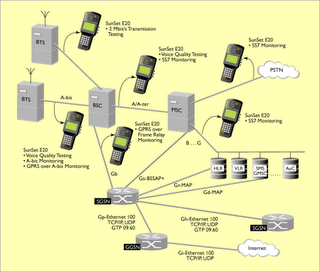Cellular Network

What is a Cellular Network?
A cellular network allows cellular subscribers to wander
anywhere in the country and remain connected to the Public Switched
Telephone Network(PSTN) via their mobile phones. A cellular network has
a hierarchical structure and it is formed by connecting the major components
mentioned below :-
- Mobile phones[1] - main piece of equipment
as far as a subscriber is concerned - Base Station(BS)
- Mobile Switching Centre(MSC)
Base Station(BS)
 | The base station serves a cell which could be a few kilometres in diameter as shown in the diagram on the left. |
Diagram 1
 | The cells when grouped together form a cluster as shown in the diagram on left. |
Diagram 2
All BSs within a cluster are connected to a Mobile Switching
Centre(MSC) using land lines. Each MSC of a cluster is then connected
to the MSC of other clusters and a PSTN main switching centre. This is shown in
diagram 3.
The MSC stores information about the subscribers located within the cluster and
is responsible for directing calls to them.
Diagram 3 shows the structure of the network explained above.

Diagram 3
 Cells
Cells
and Clusters
 Arrangement
Arrangement
of cells in a cluster
The number of cells per cluster is restricted by the requirement that the
clusters must fit together like jig-saw pieces. The possible cell clusters are
the 4-,7-,12- and 21-cell clusters.
 |
| The diagram on the left shows a 7-cell cluster which is commonly used in the UK. |
Diagram 4
 Re-using
Re-using
Frequency
In the UK the bandwidth made available for cellular networks ranges from
890 to 915MHz for base transmission and 935 to 960MHz
for mobile transmission. All transmissions are made via channels. A
channel consists of a pair of frequencies, one for each direction of
transmission that is used for full-duplex operation. In the UK at 1992, the
cellular networks had in total 1000 channels(300 allocated to Cellnet and
another 300 allocated to Vodaphone, leaving 400 in reserve for pan-European
system -GSM[2]). This would suggest that fewer
than 600 subscribers could access the system simultaneously when in fact the
number of subscribers is in the range of millions. Research undertaken by
Bell Labs has found a solution which involves re-using the same
channel frequency in many different clusters. The cells in these different
clusters using the same channel frequency must be separated far enough so that
co-channel interference[3] would not occur.
 Cell
Cell
: Shape and Size
Shapes

Diagram 5
Hexagonal shaped cells[4] shown in diagram 5
are artificial and cannot be generated in the real world. However this shape is
chosen to simplify planning and design of a cellular system as
hexagons fit together without any overlap or gap in between them.Another
advantage of using hexagons is that it approaches a circular shape which
is the ideal power coverage area. The real cell shape is as shown above
and it's shape will keep changing due to prevailing conditions.
Size
The size of the cell largely depends on the area in which the cell is
located. Generally, rural areas have less subscribers compared to urban areas.
So in an urban area more channels are needed to accommodate the larger number of
subscribers. If each cell in a given rural and urban area had fixed number of
channels, the cell size in the urban area would have to be smaller to allow more
channels in the given area. Reducing the cell size would result in cells, using
similar channel frequency, to be located closer to each other. Therefore
reducing the size too much would cause an increase in co-channel interference.
Size of the cell can be varied by varying the power and sensitivity of the base
station.
An alternative way to change the size of the cell is to split
the cell.[5] This involves reducing the radius of a cell by half
and splitting an old cell into four small cells as shown below.
Diagram 6

